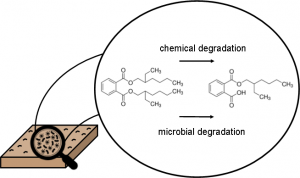We are excited to announce that our paper titled “Degradation of phthalate esters in floor dust at elevated relative humidity” was recently published under the Emerging Investigator series in the journal Environmental Science: Processes & Impacts.
This is effectively the third paper in a series exploring microbial activity in house dust at elevated relative humidity levels. The first measured microbial growth (Fungal and bacterial growth in floor dust at elevated relative humidity levels), and the second considered fungal gene expression (Gene expression of indoor fungal communities under damp building conditions: Implications for human health). All three papers were supported by the Alfred P. Sloan Foundation and were part of a Microbiology of the Built Environment Postdoctoral Fellowship. This final paper was initially started during Dr. Dannemiller’s postdoc at Yale and then we continued her work at Ohio State.
Together, these papers represent the progression in our understanding of how elevated moisture conditions in homes can impact both microbial communities and indoor chemistry. Dampness in homes is strongly associated with negative human health effects, but there is more to be understood about the processes that occur in homes under these suboptimal conditions.
Phthalates are plasticisers that are commonly found in many household products and are known endocrine disruptors. Phthalates are also commonly found in house dust. In this most recent publication, we demonstrated that phthalate degradation occurs in house dust under elevated relative humidity conditions. This degradation was due to both chemical and biological processes. Both parent and daughter compounds have known negative health effects. Gene expression analysis provided suggestive evidence of pathways that may be associated with fungal phthalate degradation in homes, but more work is needed for confirmation of these results. This work provides important information about processes occurring in damp buildings where moisture conditions could produce an unhealthy environment for humans.
Future work should explore these processes under different conditions, including those under more typical (non-water damaged) relative humidity levels and for longer periods of time.

“Future work should explore these processes under different conditions, including those under more typical (non-water damaged) relative humidity levels and for longer periods of time.”
I can tell you what happens then: nothing, because mouds and bacteria need over 75% RH in order to be active, and that includes of course metabolic porcesses. You can use the grant money to something else.